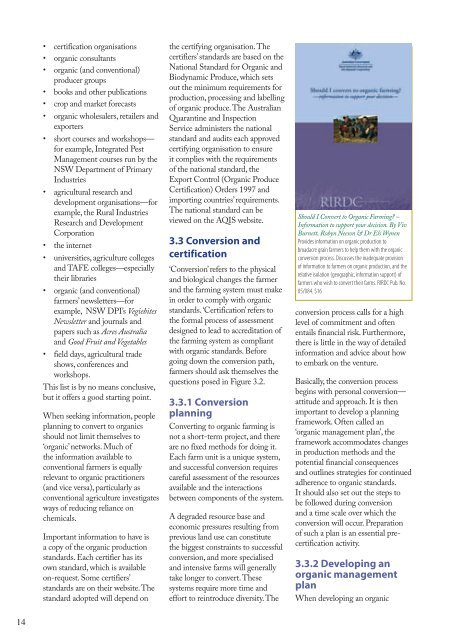4. Organic vegetable production
4. Organic vegetable production
4. Organic vegetable production
You also want an ePaper? Increase the reach of your titles
YUMPU automatically turns print PDFs into web optimized ePapers that Google loves.
• certification organisations<br />
• organic consultants<br />
• organic (and conventional)<br />
producer groups<br />
• books and other publications<br />
• crop and market forecasts<br />
• organic wholesalers, retailers and<br />
exporters<br />
• short courses and workshops—<br />
for example, Integrated Pest<br />
Management courses run by the<br />
NSW Department of Primary<br />
Industries<br />
• agricultural research and<br />
development organisations—for<br />
example, the Rural Industries<br />
Research and Development<br />
Corporation<br />
• the internet<br />
• universities, agriculture colleges<br />
and TAFE colleges—especially<br />
their libraries<br />
• organic (and conventional)<br />
farmers’ newsletters—for<br />
example, NSW DPI’s Vegiebites<br />
Newsletter and journals and<br />
papers such as Acres Australia<br />
and Good Fruit and Vegetables<br />
• field days, agricultural trade<br />
shows, conferences and<br />
workshops.<br />
This list is by no means conclusive,<br />
but it offers a good starting point.<br />
When seeking information, people<br />
planning to convert to organics<br />
should not limit themselves to<br />
‘organic’ networks. Much of<br />
the information available to<br />
conventional farmers is equally<br />
relevant to organic practitioners<br />
(and vice versa), particularly as<br />
conventional agriculture investigates<br />
ways of reducing reliance on<br />
chemicals.<br />
Important information to have is<br />
a copy of the organic <strong>production</strong><br />
standards. Each certifier has its<br />
own standard, which is available<br />
on-request. Some certifiers’<br />
standards are on their website. The<br />
standard adopted will depend on<br />
the certifying organisation. The<br />
certifiers’ standards are based on the<br />
National Standard for <strong>Organic</strong> and<br />
Biodynamic Produce, which sets<br />
out the minimum requirements for<br />
<strong>production</strong>, processing and labelling<br />
of organic produce. The Australian<br />
Quarantine and Inspection<br />
Service administers the national<br />
standard and audits each approved<br />
certifying organisation to ensure<br />
it complies with the requirements<br />
of the national standard, the<br />
Export Control (<strong>Organic</strong> Produce<br />
Certification) Orders 1997 and<br />
importing countries’ requirements.<br />
The national standard can be<br />
viewed on the AQIS website.<br />
3.3 Conversion and<br />
certification<br />
‘Conversion’ refers to the physical<br />
and biological changes the farmer<br />
and the farming system must make<br />
in order to comply with organic<br />
standards. ‘Certification’ refers to<br />
the formal process of assessment<br />
designed to lead to accreditation of<br />
the farming system as compliant<br />
with organic standards. Before<br />
going down the conversion path,<br />
farmers should ask themselves the<br />
questions posed in Figure 3.2.<br />
3.3.1 Conversion<br />
planning<br />
Converting to organic farming is<br />
not a short-term project, and there<br />
are no fixed methods for doing it.<br />
Each farm unit is a unique system,<br />
and successful conversion requires<br />
careful assessment of the resources<br />
available and the interactions<br />
between components of the system.<br />
A degraded resource base and<br />
economic pressures resulting from<br />
previous land use can constitute<br />
the biggest constraints to successful<br />
conversion, and more specialised<br />
and intensive farms will generally<br />
take longer to convert. These<br />
systems require more time and<br />
effort to reintroduce diversity. The<br />
Should I Convert to <strong>Organic</strong> Farming? –<br />
Information to support your decision. By Viv<br />
Burnett, Robyn Neeson & Dr Els Wynen<br />
Provides information on organic <strong>production</strong> to<br />
broadacre grain farmers to help them with the organic<br />
conversion process. Discusses the inadequate provision<br />
of information to farmers on organic <strong>production</strong>, and the<br />
relative isolation (geographic, information support) of<br />
farmers who wish to convert their farms. RIRDC Pub. No.<br />
05/08<strong>4.</strong> $16<br />
conversion process calls for a high<br />
level of commitment and often<br />
entails financial risk. Furthermore,<br />
there is little in the way of detailed<br />
information and advice about how<br />
to embark on the venture.<br />
Basically, the conversion process<br />
begins with personal conversion—<br />
attitude and approach. It is then<br />
important to develop a planning<br />
framework. Often called an<br />
‘organic management plan’, the<br />
framework accommodates changes<br />
in <strong>production</strong> methods and the<br />
potential financial consequences<br />
and outlines strategies for continued<br />
adherence to organic standards.<br />
It should also set out the steps to<br />
be followed during conversion<br />
and a time scale over which the<br />
conversion will occur. Preparation<br />
of such a plan is an essential precertification<br />
activity.<br />
3.3.2 Developing an<br />
organic management<br />
plan<br />
When developing an organic<br />
14

















